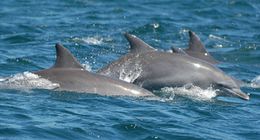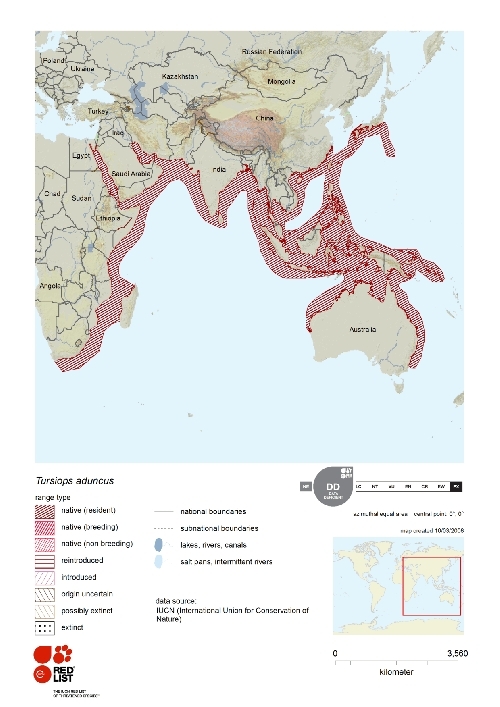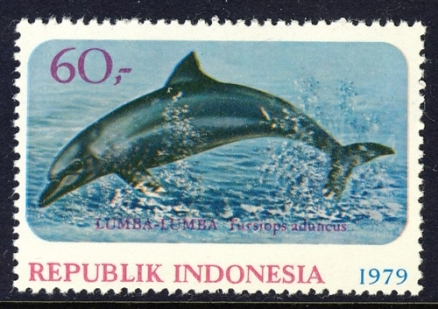Indian Ocean bottlenose dolphin
The Indian Ocean bottlenose dolphin (scientific name: Tursiops aduncus) is one of 36 species of Oceanic Dolphins in the family Delphinidae. This cetacean was only recently recognized as a distinct and separate species from the Common bottlenose dolphin (Tursiops truncatus). Additional information on this related species can be found in the article Common bottlenose dolphin.
 Tursiops aduncus. Source: Liz Hawkins/New South Wales Marine parks Authority Tursiops aduncus. Source: Liz Hawkins/New South Wales Marine parks Authority
|
|
Conservation Status: |
|
Scientific Classification Kingdom: Animalia |
|
Common Names: |
Contents
Behaviour
The Indian Ocean bottlenose dolphin is sometimes found in groups that include Common bottlenose dolphins or other oceanic dolphins.
Distribution and Movements
The Indo-Pacific Bottlenose Dolphin has a discontinuous distribution in the warm temperate to tropical Indo-Pacific, from South Africa in the west, along the rim of the Indian Ocean (including the Red Sea, Persian Gulf, South China Sea, Sulu Sea, Celebes Sea and other coastal parts of the Indo-Malay Archipelago as far east as the Solomon Islands and possibly New Caledonia) to the southern half of Japan and southeast Australia in the east (Wells and Scott 2002; Möller and Beheregaray 2001). It is also found around oceanic islands distant from major landmasses within this range. (IUCNRed List)
Habitat
The Indian Ocean bottlenose dolphin is most often found in shallow coastal waters
Feeding Habits
The Indian Ocean bottlenose dolphin feeds on a gamut of schooling, demersal and reef fishes, as well as cephalopods. (IUCNRedlist)
Threats and Conservation Status
The IUCN Redlist reports that the species near-shore distribution makes it vulnerable to environmental degradation (Habitat destruction), direct exploitation, and fishery conflicts (Curry and Smith 1997, Wells and Scott 1999; Reeves et al. 2003). Until hunting was outlawed in 1990, this species was hunted in a large-scale drive fishery in Taiwan’s Penghu Islands. Some Indo-Pacific bottlenose dolphins are taken in the small cetacean fisheries of Sri Lanka.
Incidental catches occur in a number of fisheries throughout the range, including gillnets and purse seines. A Taiwanese shark gillnet fishery operated in northern Australian waters during the early 1980s and took up to 2000 per year (Harwood and Hembree 1987). Incidental catch in Taiwan continues to be a serious problem. For example, multiple individuals have been seen observed in single catches there and throughout most of the species’ range (J.Y. Wang pers. comm.). A large proportion of dolphins (~40%) off Bangladesh exhibit scars and mutilations consistent with rope and net entanglement in trawl and gill-net fisheries (Rubaiyat Mansur Mowgli and Brian D. Smith pers. comm.). In South Africa and Australia, Indo-Pacific Bottlenose dolphins also suffer considerable mortality in the large-mesh nets set to protect bathers from sharks (Peddemors 1999; Reeves et al. 2003).
Live-captures for oceanarium display have taken place in Taiwan, Indonesia and the Solomon Islands in recent years from unassessed populations; their preference as a captive display species makes them vulnerable to depletion from such catches (Wang et al. 1999, Reeves et al. 2003, Kahn).
Indo-Pacific bottlenose dolphins in coastal areas are exposed to a wide variety of threats in addition to direct and indirect takes. Threats that are cause for concern include: 1) the toxic effects of xenobiotic chemicals; 2) reduced prey availability caused by environmental degradation (Habitat destruction) and overfishing (Jackson et al. 2001); 3) direct and indirect disturbance and harassment (e.g. boat traffic and commercial dolphin watching and interactive programs); 4) marine construction and demolition and 5) other forms of habitat destruction and degradation (including anthropogenic noise). Although these and other threats are technically challenging to quantify by comparison with takes, their cumulative impact is likely to result in longitudinal population declines. Lack of historical data in many cases hampers understanding of long-term population trends, possibly resulting in shifting baselines.
References
- Frankis.M. Ed. 2011. Tursiops aduncus. Encyclopedia of Life
- Hammond, P.S., Bearzi, G., Bjørge, A., Forney, K., Karczmarski, L., Kasuya, T., Perrin, W.F., Scott, M.D., Wang, J.Y., Wells, R.S. & Wilson, B. 2008. Tursiops aduncus. In: IUCN 2010. IUCN Red List of Threatened Species. Version 2010.4. . Downloaded on 31 March 2011.
- Chilvers, B. L. and Corkeron, P. 2003. Abundance of Indo-Pacific bottlenose dolphins, Tursiops aduncus, off Point Lookout, Queensland, Australia. Marine Mammal Science 19(1): 85-95.
- Cockcroft, V. G., Ross, G. J. B., Peddemors, V. M. and Borchers, D. L. 1992. Estimates of abundance and undercounting of bottlenose dolphins off northern Natal, South Africa. South African Journal of Wildlife Research 22: 102-109.
- Curry, B. E. and Smith, J. 1997. Phylogeographic structure of the bottlenose dolphin (Tursiops truncatus): stock identification and implications for management. In: A. E. Dizon, S. J. Chivers and W. F. Perrin (eds), Molecular genetics of marine mammals, pp. 227-247. The Society of Marine Mammalogy, Allen Press, Lawrence.
- Harwood, M. B. and Hembree, D. 1987. Incidental catch of small cetaceans in the offshore gillnet fishery in northern Australian waters: 1981-1985. Reports of the International Whaling Commission 37: 363-367.
- Jackson, J. B. C., Kirby, M. X., Berger, W. H., Bjorndal, K. A., Botsford, L. W., Bourque, B. J., Bradbury, R. H., Cooke, R., Erlandson, J., Estes, J. A., Hughes, T. P., Kidwell, S., Lange, C. B., Lenihan, H. S., Pandolfi, J. M., Peterson, C. H., Steneck, R. S., Tegner, M. J. and Warner, R. R. 2001. Historical overfishing and the recent collapse of coastal ecosystems. Science 293: 629-637.
- Kahn, B. 2006. Oceanic cetaceans and associated habitats in the western Solomon Islands. In: A. Green, P. Lokani, W. Atu, P. Ramohia, P. Thomas and J. Almany (eds), Solomon Islands Marine Assessment: technical report of marine survey – May 13 to June 17, 2004. The Nature Conservancy – Pacific Islands Countries Report.
- Kogi, K., Hishii, T., Imamura, A., Iwatani, T. and Dudzinski, K. M. 2004. Demographic parameters of Indo-Pacific bottlenose dolphins (Tursiops aduncus) around Mikura Island, Japan. Marine Mammal Science 20(3): 510-526.
- Mead, James G., and Robert L. Brownell, Jr. / Wilson, Don E., and DeeAnn M. Reeder, eds. 2005. Order Cetacea. Mammal Species of the World: A Taxonomic and Geographic Reference, 3rd ed., vol. 1. 723-743
- Moller, L. M. and Beteregaray, L. B. 2001. Coastal bottlenose dolphins from southeastern Australia are Tursiops aduncus according to sequences of the mitochondrial DNA control region. Marine Mammal Science 17(2): 249-263.
- Natoli, A., Peddemors, V. M. and Hoelzel, A. R. 2004. Population structure and speciation in the genus Tursiops based on microsatellite and mitochondrial DNA analyses. Journal of Evolutionary Biology 17: 363-375.
- Peddemors, V. M. 1999. Delphinids of southern Africa: a review of their distribution, status and life history. Journal of Cetacean Research and Management 1(2): 157-165.
- Perrin, W. (2010). Tursiops aduncus (Ehrenberg, 1832). In: Perrin, W.F. World Cetacea Database. Accessed through: Perrin, W.F. World Cetacea Database (accessed 2011-03-18)
- Preen, A. 2004. Distribution, abundance and conservation status of dugongs and dolphins in the southern and western Arabian Gulf. Biological Conservation 118: 205-218.
- Preen, A. R., Marsh, H., Lawler, I. R., Prince, R. I. T. and Shepherd, R. 1997. Distribution and abundance of dugongs, turtles, dolphins and other megafauna in Shark Bay, Ningaloo Reef and Exmouth Gulf, Western Australia. Wildlife Research 24(2): 185-208.
- Reeves, R. R., Smith, B. D., Crespo, E. A. and Notarbartolo di Sciara, G. 2003. Dolphins, Whales and Porpoises: 2002-2010 Conservation Action Plan for the World's Cetaceans. IUCN/SSC Cetacean Specialist Group, Gland, Switzerland and Cambridge, UK.
- Rice, D. W. 1998. Marine mammals of the world: systematics and distribution. Society for Marine Mammalogy.
- Ross, G. J. B. 1984. The smaller cetaceans of the south east coast of southern Africa. Annals of the Cape Provincial Museums (Natural History) 15: 173-410.
- Shirakihara, M., Shirakihara, K., Tomonaga, J. and Takatsuki, M. 2002. A resident population of Indo-Pacific bottlenose dolphins (Tursiops aduncus) in Amakusa, western Kyushu, Japan. Marine Mammal Science 18(1): 30-41.
- Stensland, E., Carlen, I., Sarnblad, A., Bignert, A. and Berggren, P. 2006. Population size, distribution, and behavior of Indo-Pacific bottlenose (Tursiops aduncus) and humpback (Sousa chinensis) dolphins off the south coast of Zanzibar. Marine Mammal Science 22(3): 667-682.
- UNESCO-IOC Register of Marine Organisms Search! Wilson, Don E., and DeeAnn M. Reeder, eds. 1993. Mammal Species of the World: A Taxonomic and Geographic Reference, 2nd ed., 3rd printing. xviii + 1207
- Wang, J. Y., Chou, L. S. and White, B. N. 1999. Mitochondrial DNA analysis of sympatric morphotypes of bottlenose dolphins (genus: Tursiops) in Chinese waters. Molecular Ecology 8: 1603-1612.
- Wang, J. Y., Chou, L. S. and White, B. N. 2000. Differences in external morphology of two sympatric species of bottlenose dolphins (genus Tursiops) in the waters of China. Journal of Mammalogy 81(4): 1157-1165.
- Wang, J. Y., Chou, L. S. and White, B. N. 2000. Osteological differences between two sympatric forms of bottlenose dolphins (genus Tursiops) in Chinese waters. Journal of Zoology (London) 252: 147-162.
- Wells, R. S. and Scott, M. D. 1999. Bottlenose dolphin Tursiops truncatus (Montagu, 1821). In: S. H. Ridgway and R. Harrison (eds), Handbook of marine mammals, Vol. 6: The second book of dolphins and the porpoises, pp. 137-182. Academic Press, San Diego, CA, USA.
- Wells, R. S. and Scott, M. D. 2002. Bottlenose dolphins Tursiops truncatus and T. aduncus. In: W. F. Perrin, B. Wursig and J. G. M. Thewissen (eds), Encyclopedia of Marine Mammals, pp. 122-128. Academic Press.

